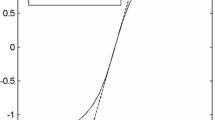Abstract
Recently, Long Term Evolution Advanced (LTE-A) has been widely deployed for the fourth generation wireless communication system due to its high spectral utilization and throughput performance compared with the other systems. LTE-A adopts the Primary Synchronization Signal (PSS), which is generated from the frequency-domain Zadoff–Chu sequence to complete the synchronization and cell search at the receiver. Rather than the full cross-correlation search of the conventional synchronization method, in this paper, we propose a blind and low-complexity synchronization method that utilizes the time-domain symmetric property of PSS sequence. Results show that the proposed method can predict the arrival time and frequency offset of the received signal precisely and has the low-complexity advantage.









Similar content being viewed by others
References
3GPP TS36.211 (V10.5.0). (2012). Evolved universal terrestrial radio access (E-UTRA), physical channels and modulation (Release 10).
Sesia, Stefania, Toufik, Issam, & Baker, Matthew. (2009). The UMTS long term evolution from theory to practice. London: Wiley.
Popovic, B. M., & Berggren, F. (2008) Primary Synchronization Signal in E-UTRA. In IEEE international symposium on spread spectrum techniques and applications (ISSSTA), Bologna, Italy, pp. 426–430.
Schmidl, T. M., & Cox, D. C. (1997). Robust frequency and timing synchronization for OFDM. IEEE Transactions on Communications, 45(12), 1613–1621.
Park, B., Cheon, H., Kang, C., & Hong, D. (2003). A novel timing estimation method for OFDM systems. IEEE Communications Letters, 7(5), 239–241.
Van de Beek, J.-J., Sandell, M., & Borjesson, P. O. (1997). ML estimation of time and frequency offset in OFDM systems. IEEE Transactions on Signal Processing, 45(7), 1800–1805.
Kim, Y., & Chang, K. (2009). Complexity optimized CP length pre-decision metric for cell searcher in the downlink of 3GPP LTE system. In IEEE international symposium on personal, indoor and mobile radio communications, Tokyo, pp. 895–899.
Yang, X., Xiong, Y., Jia, G., Fang, W. & Zheng, X. (2011). PSS based time synchronization for 3GPP LTE downlink receivers. In IEEE international conference on communication technology (ICCT), Jinan, pp. 930–933.
Author information
Authors and Affiliations
Corresponding author
Rights and permissions
About this article
Cite this article
Li, CM., Lin, CH. A Low-Complexity Synchronization Method for LTE-A System Based on the Symmetric Time Domain Zadoff–Chu Sequence. Wireless Pers Commun 83, 2359–2370 (2015). https://doi.org/10.1007/s11277-015-2532-x
Published:
Issue Date:
DOI: https://doi.org/10.1007/s11277-015-2532-x




